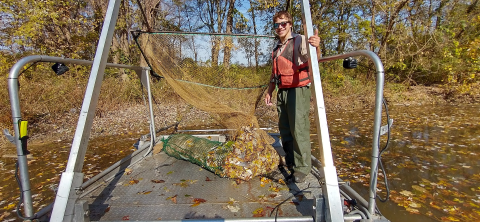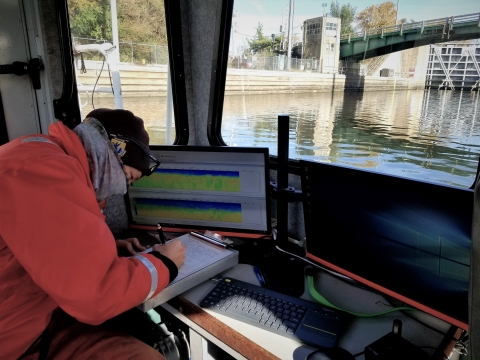Projects and Research
Invasive Carp Projects
The Carterville FWCO and Wilmington Substation work with other agencies and partners to expand control and management efforts for invasive silver, bighead, grass, and black carps to a national scale. These efforts include prioritizing the implementation of the Great Lakes Restoration Initiative Action Plan and an annual Invasive Carp Action Plan and complementary Monitoring and Response Plan overseen by the Invasive Carp Regional Coordinating Committee (ICRCC).
Early Detection and Monitoring - Staff at the Carterville FWCO and Wilmington Substation use fish capture gears (e.g., boat electrofishing, electrified dozer trawl, mini-fyke nets) to search for invasive carps at the upstream edge of their known range: the upper Illinois Waterway, Chicago Area Waterway System, the Ohio River, and tributaries of concern (e.g., Des Plaines and Kankakee rivers). Early Detection and Monitoring improves our understanding of the distribution of adult and juvenile carps in relation to the Great Lakes and gives managers the opportunity to respond to any potential spread before these fishes become established.
Carterville FWCO Hydroacoustics - Carterville FWCO staff use hydroacoustic techniques as a part of a comprehensive plan to manage silver and bighead carps throughout the Ohio River Basin. These efforts include surveys of the navigation pools and tributaries of the Ohio River and the evaluation of mass removal events in Kentucky Lake and Lake Barkley. For survey efforts, Carterville staff coordinate with the Indiana Department of Natural Resources and Kentucky Department of Fish and Wildlife Resources to use hydroacoustic sampling, paired with fish community sampling, to estimate the density and spatial distribution of silver and bighead carps. Additionally, Carterville staff collaborate with the U.S. Geological Survey to evaluate the effectiveness of mass harvest events targeted at removing silver and bighead carps in Kentucky Lake and Lake Barkley. For these events, hydracoustic surveys are performed prior to and following the removal event to determine the effectiveness of removal efforts. Both the surveys and the evaluations of removal efforts contribute to the larger goal of managing and controlling silver and bighead carps within the Ohio River Basin.
Carterville FWCO Acoustic Telemetry – Acoustic telemetry in the Ohio River Basin is focused on quantifying lock and dam passage, habitat use, and survival rates of silver and bighead carps throughout a >800 mile stretch of the Ohio River from its confluence with the Mississippi River to Willow Island Lock and Dam (Ohio-West Virginia border). Given the broad expansion and establishment of silver and bighead carps within the Ohio River Basin, understanding their movement patterns and interactions with their environment is critical to management efforts aimed at slowing their spread into novel habitats. Each fish is surgically implanted with an acoustic transmitter, allowing scientists to track their movements using a large array of receivers. This is a large, collaborative effort between the Carterville FWCO and state and academic partners from Illinois, Indiana, Kentucky, Ohio, and West Virginia.
eDNA – Environmental DNA, or eDNA, is species-specific DNA material from an organism that is shed or excreted into the environment. In the Upper Ohio River eDNA sampling is used in addition to other methods to monitor and detect emerging populations of silver and bighead carps. Carterville FWCO staff collects and preserves eDNA water samples in the field. The samples are then processed for silver and bighead carp DNA by Whitney Genetics Lab staff.
Wilmington Substation
Upper Illinois Waterway Hydroacoustics - The Wilmington Substation staff conduct hydroacoustic surveys in the upper Illinois Waterway. Hydroacoustic surveys inform partners (e.g., U.S. Army Corps of Engineers and Illinois DNR) of the presence and abundance of large (>12 inches) fish near the primary barrier preventing silver and bighead carps from reaching Lake Michigan, The Electric Dispersal Barrier System (EDBS) in Romeoville, IL. Examining patterns of fish abundance near the EDBS, and in the reaches (i.e., navigation pools) immediately downstream of the EDBS, helps partners plan EDBS maintenance and manage the risk of silver and bighead carps spreading towards Lake Michigan.
Acoustic Telemetry Support for Invasive Carp Population Modeling - Staff at the Wilmington Substation partner with other agencies to maintain an array of acoustic telemetry receivers in Peoria and Starved Rock pools of the Illinois Waterway. Acoustic telemetry involves implanting transmitters into individual fish to track their movements, habitat use, and behavior. Data gathered from tagged fish help scientists understand invasive carp movement patterns in the Illinois Waterway and how often these fishes move between pools by passing through the Illinois Waterway’s locks and dams.
Barge Entrainment Mitigation - The Wilmington Substation continues to partner with the U.S. Army Corps of Engineers and U.S. Geological Survey to conduct studies evaluating probability that cargo barges, which routinely move between the Mississippi River Basin and the Great Lakes, unintentionally trap fishes (i.e., silver and bighead carps) and transport them between these systems. Barges carrying cargo in the Illinois Waterway often pass through the Electric Dispersal Barrier System (EDBS)—the main fish barrier separating the Mississippi River system and the Great Lakes—on their way to Lake Michigan. Because the steel hulls of barges can deflect the EDBS’ electric field, understanding if barges can trap and move silver and bighead carps will help scientists determine the risk of species transfer by barge traffic, and test the effectiveness of techniques to remove these trapped fish (e.g., bubble curtains).

